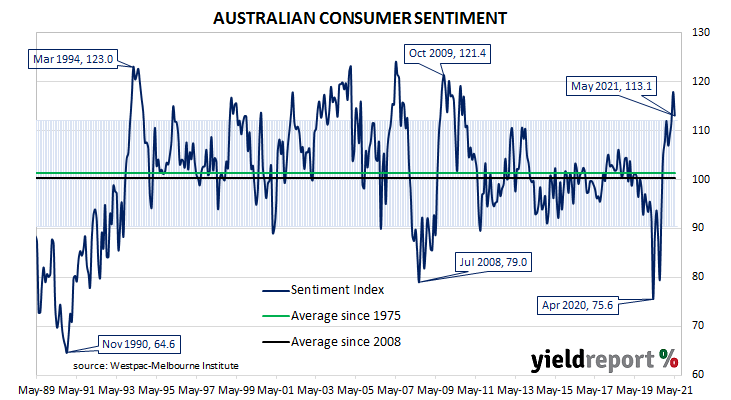Summary: Household sentiment softens in May; still “second-highest” reading since 2010; sentiment index still substantially above long-term average; all five sub-indices lower; unemployment index lower; “limited uplift” from Federal Budget.
After a lengthy divergence between measures of consumer sentiment and business confidence in Australia which began in 2014, confidence readings of the two sectors converged again around July 2018. Both readings then deteriorated gradually in trend terms, with consumer confidence leading the way. Household sentiment fell off a cliff in April 2020 but, after a few months of to-ing and fro-ing, it then staged a full recovery.
According to the latest Westpac-Melbourne Institute survey conducted in early May, household sentiment has softened while remaining at an elevated level. The Consumer Sentiment Index declined from April’s reading of 118.8 to 113.1.
“While a 4.8% fall is always going to attract attention we should put this result in perspective. It is still the second-highest print for the Index since April 2010 and does follow an 11% rise in the Index over the previous three months,” said Westpac chief economist Bill Evans.
Any reading of the Consumer Sentiment Index above 100 indicates the number of consumers who are optimistic is greater than the number of consumers who are pessimistic. The latest figure is still substantially above the long-term average reading of just over 101.

In the cash futures market, expectations of a change in the actual cash rate, currently at 0.03%, remained largely unchanged. At the end of the day, contract prices implied the cash rate would rise slowly, reaching 0.11% by September 2022.
All five sub-indices registered lower readings; the “Family finances – next 12 months” sub-index experienced the largest monthly percentage decline, followed by the “Economic conditions – next 5 years” sub-index.
The Unemployment Expectations index, formerly a useful guide to RBA rate changes, fell from 118.4 to 100.2. Lower readings result from more respondents expecting a lower unemployment rate in the year ahead.

